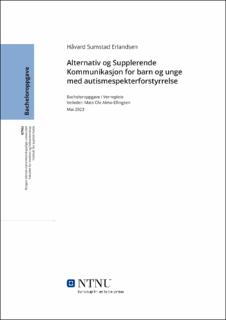| dc.contributor.advisor | Almo Ellingsen, Mats Ole. | |
| dc.contributor.author | Sumstad Erlandsen, Håvard. | |
| dc.date.accessioned | 2023-07-13T17:22:50Z | |
| dc.date.available | 2023-07-13T17:22:50Z | |
| dc.date.issued | 2023 | |
| dc.identifier | no.ntnu:inspera:143262155:70428419 | |
| dc.identifier.uri | https://hdl.handle.net/11250/3078829 | |
| dc.description.abstract | Sammendrag
Tittel: Alternativ og supplerende kommunikasjon (ASK) for barn og unge med autismespekterforstyrrelse.
Introduksjon/bakgrunn: En av de vanligste kjennetegnene ved autismespekterforstyrrelser (ASF) er kommunikasjonsvansker. Mange barn og unge med autismespekterforstyrrelser har forsinket eller begrenset språkutvikling samt manglende funksjonell talespråk. I slike tilfeller kan alternativ og supplerende kommunikasjon (ASK) være en verdifull ressurs for å øke kommunikasjonsevnen i samhandling med andre. ASK finnes i ulike former og må tilpasses den enkeltes behov og forutsetninger.
Hensikt: Formålet med litteraturstudien er å utforske bruken av ASK som et verktøy for kommunikasjon hos barn med autismespekterforstyrrelser og hvordan ASK kan være til støtte i samhandling med jevnaldrende.
Metode: Denne oppgaven benytter seg av metoden litteraturstudie, og tar for seg fem ulike
forskningsartikler, samt annen relevant litteratur.
Resultat: Samtlige artikler som er inkludert i oppgaven, viser til funn om at ASK har en positiv effekt på kommunikasjonsevnen hos barn og unge med autisme. Resultatdelen fremhever to hovedtemaer som videre ble fokusert på i oppgaven: 1) Kommunikasjonsevne 2) Samhandling
Konklusjon: Forskning viser at ASK kan være et effektivt verktøy for å støtte kommunikasjon og samhandling med jevnaldrende for barn og unge med autisme. Ved å bruke ASK kan man øke kommunikasjonsevnen, opprettholde sosial interaksjon og fremme inkludering i det sosiale fellesskapet.
Nøkkelord: Alternativ og supplerende kommunikasjon, autismespekterforstyrrelse, barn og unge, samhandling, inkludering
Antall ord: 7093 | |
| dc.description.abstract | Abstract
Title: Alternative and Augmentative Communication (AAC) for Children and Youth with Autism Spectrum Disorder.
Introduction/Background: One of the most common characteristics of Autism Spectrum Disorder (ASD) is communication difficulties. Many children and youth with ASD experience delayed or limited language development, as well as a lack of functional spoken language. In such cases, Alternative and Augmentative Communication (AAC) can be a valuable resource to enhance communication abilities in interactions with others. AAC comes in various forms and must be tailored to the individual's needs and abilities.
Objective: The aim of this literature review is to explore the use of AAC as a communication tool for children with ASD and how AAC can support interaction with peers.
Method: This study utilizes a literature review methodology, examining five different research articles along with other relevant literature.
Results: All the articles included in this study highlight the positive impact of AAC on communication abilities in children and youth with autism. The results section emphasizes two main themes that were further explored in the study: 1) Communication abilities and 2) Interaction.
Conclusion: Research indicates that AAC can be an effective tool to support communication and interaction with peers for children and youth with autism. By using AAC, communication abilities can be enhanced, social interaction can be facilitated, and inclusion within the social community can be promoted.
Keywords: Alternative and Augmentative Communication, Autism Spectrum Disorder, children and youth, interaction, inclusion.
Word count: 7093 | |
| dc.language | nob | |
| dc.publisher | NTNU | |
| dc.title | Alternativ og supplerende kommunikasjon (ASK) for barn og unge med autismespekterforstyrrelse | |
| dc.type | Bachelor thesis | |
